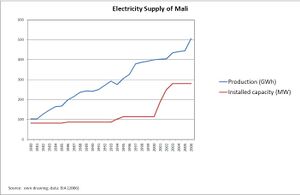Mali Energy Situation
Situation analysis and framework conditions
Energy situation especially in rural areas
Energy demand and supply in the household sector
Households (mostly rural poor) consume 86% of Mali’s energy, (road) transport 10%, industry (mainly mining) 3% and agriculture 1% (2003 figures). 80 % of total energy consumption is based on firewood and charcoal (increasing by 3% and 10% annually, respectively). Oil products account for 16% (annual increase 10%), placing a heavy financial burden on the national economy which is wholly dependent on oil imports. Electricity accounts for only 3% of Mali’s energy consumption and less than 20% of the total population are connected to the national grid. Mali's power grid covers only a few urban areas, leaving more than 97% of the rural population without access to electricity. However, only fractions of Mali’s huge renewable power generating potential (hydro, solar) are exploited. In recent years, the necessity of tapping these resources for rural electrification was clearly identified.
The total electricity generation in 2006 was about 505 GWh and the installed capacity was 280 MW. Since 1980 the consumption increased constantly, while the installed capacity of all plants remained in the 1980s and 1990s at the same level. Recently at the beginning of the new century the pattern changed and new production facilities were build (see graph).
EDM, the state energy utility, is expected to reach only 60 urban locations through the national grid.
Rural electricity supply
The existing national electrification policies are not yet ready to close the existing energy gap: EDM, the state energy utility, is expected to reach only 60 urban locations through the national grid. Mali's Agency for Domestic Energy and Rural Electrification (AMADER), whose rural electrification strategy focuses on the creation of a private sector in which public/private partnerships on a local level should take a lead role in the rural electrification process, seems to be completely surpassed by the task to provide the off-grid majority of over 700 rural communes (11.000 villages) with access to electricity.
Both central state institutions have neither the capacity nor the resources to achieve their national goal. Most remote rural areas will not be targeted and even if there are no local capacities available who could implement the ambitious programmes. They also insufficiently interlink electricity provision with decentralisation politics and; fail to involve the local municipalities in planning and running the energy facilities which is crucially important to ensure their long-term sustainability. Without tapping this potential of participatory communal development, the national goal of reaching 12% rural electrification rate by 2012 and 55 % by 2015 will be out of reach.
The national goal of reaching 12% rural electrification rate by 2012 and 55 % by 2015 is out of reach.
Institutional set up and actors in the energy sector
Public institutions
Electricity companies
Non governmental service providers for rural areas in the field of energy
Micro-Finance Institutions:




















